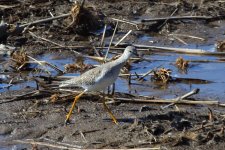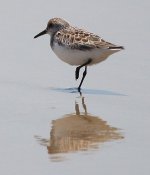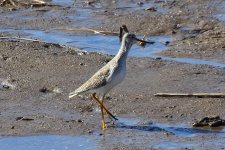Larry Lade
Moderator
The bill of the yellowlegs in the first photo is longer than the width of the head. It also, to me, does not look "petite" enough for a LEYE. The bills of both LEYE and GRYE can be dark (no yellow showing), see http://sdakotabirds.com/diffids/less...yellowlegs.htm from above.
OP states that the two photos might be of the same bird.
Also from above: " They (GRYE) seem to tolerate cold weather slightly better than the Lesser Yellowlegs, and early spring or late fall birds are more likely to be Greater Yellowlegs." (my bold)
* OP's photos of the yellowlegs were taken on February 19th.
OP states that the two photos might be of the same bird.
Also from above: " They (GRYE) seem to tolerate cold weather slightly better than the Lesser Yellowlegs, and early spring or late fall birds are more likely to be Greater Yellowlegs." (my bold)
* OP's photos of the yellowlegs were taken on February 19th.







